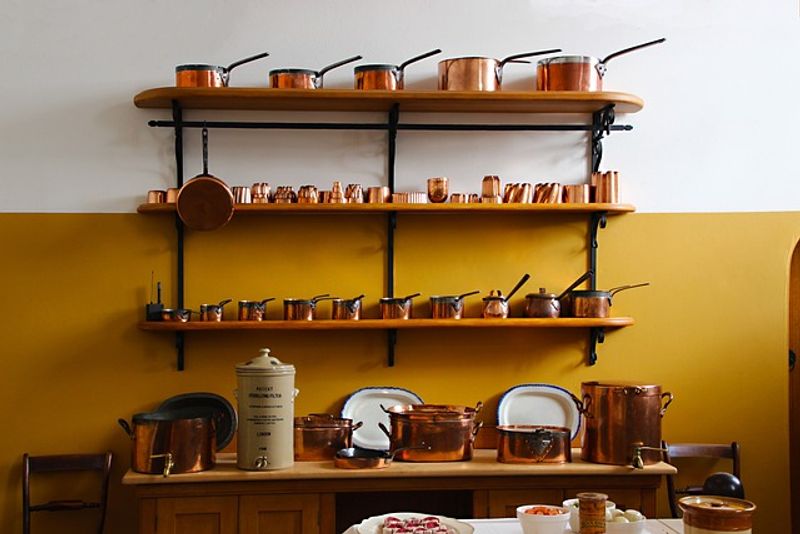
Copper cookware is not just a kitchen tool; it’s a statement piece that can elevate your cooking experience to new heights. The pros of using copper cookware go beyond its stunning appearance—it’s a material that offers a range of benefits that can enhance your culinary creations.
One of the primary advantages of copper cookware is its excellent heat conductivity. Copper is known for distributing heat evenly and quickly, allowing for precise temperature control. This means that your food cooks more evenly, reducing the risk of hot spots and ensuring that each dish is cooked to perfection. Whether you’re searing a steak or simmering a delicate sauce, copper cookware can help you achieve professional-level results in your own kitchen.
Additionally, copper cookware is incredibly responsive to temperature changes. This means that when you adjust the heat source, the copper pan or pot will respond almost immediately. This responsiveness gives you greater control over the cooking process, allowing you to make quick adjustments as needed. It’s this level of control that sets copper cookware apart from other materials and makes it a favorite among chefs and home cooks alike.
Moreover, copper cookware is not just functional; it’s also a beautiful addition to any kitchen. The warm, lustrous sheen of copper adds a touch of elegance and sophistication to your cooking space. Displaying your copper pots and pans can instantly elevate the aesthetic appeal of your kitchen, turning it into a culinary haven that’s both stylish and practical.

However, despite its many benefits, there are some cons of copper cookware that you should be aware of. One of the primary drawbacks is its high cost. Copper cookware is considered a premium option, and its price tag reflects that. While the initial investment may be steep, many cooking enthusiasts believe that the long-term benefits of copper cookware justify the expense.
Another potential downside of copper cookware is its maintenance requirements. Copper can tarnish over time, developing a patina that some find charming but others may not prefer. To keep your copper cookware looking its best, you’ll need to polish it regularly to maintain its shine. Additionally, copper cookware is not dishwasher safe and requires hand-washing with care to preserve its quality.
In conclusion, the pros of copper cookware, from its excellent heat conductivity to its aesthetic appeal, make it a valuable addition to any kitchen. While there are cons to consider, such as the initial cost and maintenance needs, the benefits of using copper cookware are undeniable. Investing in copper cookware can transform your cooking experience and bring a touch of luxury to your culinary endeavors. If you’re ready to upgrade your kitchen arsenal, consider adding copper cookware to your collection and experience the difference it can make in your cooking.
The Beauty and Benefits of Copper Cookware
Copper cookware doesn’t just enhance your cooking; it adds a touch of elegance and sophistication to your kitchen. The beauty of copper goes beyond its functional benefits—it’s a statement piece that can become a focal point in your culinary space. Whether displayed on a pot rack or showcased on your countertops, copper cookware exudes a timeless charm that captures the attention of all who enter your kitchen.
In addition to its aesthetic appeal, copper cookware offers a range of functional benefits that make it a top choice for cooking enthusiasts. The excellent heat conductivity of copper ensures that your food cooks evenly and consistently, resulting in dishes that are perfectly cooked every time. From searing steaks to caramelizing sugar, copper cookware excels in tasks that require precise temperature control and quick responsiveness.
One of the standout features of copper cookware is its ability to conduct heat better than many other materials. This superior heat conductivity allows you to achieve professional-level results in your home kitchen, making copper cookware a favorite among chefs and home cooks alike. When you use copper pans and pots, you’ll notice a difference in how your food cooks—faster, more evenly, and with greater control over the cooking process.
Moreover, copper cookware is not just a functional tool; it’s also a health-conscious choice for your kitchen. Copper is naturally antimicrobial, meaning that it has properties that resist the growth of microbes and bacteria. This makes copper cookware a hygienic option for cooking and preparing food, giving you peace of mind knowing that your cookware is helping to maintain a clean and safe cooking environment.
While the benefits of copper cookware are plentiful, it’s essential to consider some potential drawbacks as well. One of the cons of copper cookware is its high cost compared to other materials. Copper cookware is an investment, and while it offers exceptional performance and aesthetic appeal, the initial price tag may be a deterrent for some consumers. Additionally, copper cookware requires specific care and maintenance to keep it looking its best, including regular polishing and hand-washing.
The Downside of Copper Cookware
While copper cookware offers a myriad of advantages, it’s essential to be aware of the potential downsides that come with using this material in your kitchen. Understanding the cons of copper cookware can help you make an informed decision about whether it’s the right choice for your cooking needs.

One of the primary drawbacks of copper cookware is its reactivity with certain foods. Copper is a reactive metal, meaning that it can interact with acidic ingredients, leading to a metallic taste in your food. This reactivity can be particularly problematic when cooking highly acidic foods like tomatoes, citrus fruits, or vinegar-based dishes. To mitigate this issue, many copper cookware sets feature a lining, such as stainless steel or tin, which acts as a barrier between the copper and the food to prevent unwanted reactions.
Additionally, copper cookware requires regular maintenance to keep it in top condition. Copper is prone to tarnishing and discoloration over time, especially when exposed to air and moisture. To maintain the luster of your copper pots and pans, regular polishing is necessary. This upkeep can be time-consuming and may require additional care compared to other cookware materials like stainless steel or non-stick coatings.
Another consideration when using copper cookware is its weight. Copper is a heavy metal, and cookware made from this material can be significantly heavier than alternatives like aluminum or stainless steel. While the weight of copper cookware contributes to its durability and heat retention properties, it can also make handling and maneuvering pots and pans more challenging, especially for individuals with strength or mobility limitations.
Furthermore, copper cookware is not dishwasher safe. The harsh detergents and high temperatures in dishwashers can damage the delicate lining and exterior of copper pots and pans. To preserve the integrity of your copper cookware, hand-washing is recommended using mild soap and a soft sponge. While hand-washing allows you to control the cleaning process and prevent damage, it can be a time-consuming task, adding an extra step to your post-cooking routine.
In conclusion, while copper cookware offers numerous benefits, including excellent heat conductivity, aesthetic appeal, and antimicrobial properties, it also comes with its share of challenges. From reactivity with certain foods to the need for regular maintenance and care, there are cons to consider when investing in copper cookware. By understanding the potential drawbacks and taking proactive steps to address them, you can enjoy the advantages of copper cookware while minimizing its limitations in your kitchen.

Your prose feels like a soft echo, reverberating subtly in the mind. It lingers, leaving impressions of insight and calm that grow with each reading.